Water Supply Security—Risk Management Instruments in Water Supply Companies
Abstract
1. Introduction
2. Materials and Methods
2.1. Hazard Analysis
- 1—low (all > 1000 a),
- 2—medium (every 101–1000 a) and
- 3—high (all 0–100 a).
- 1—not relevant,
- 2—selectively and
- 3—area-wide.
2.2. Vulnerability Analysis with Balance Sheet Structure Models (BSM)
2.2.1. Calculation Approach
2.2.2. Modelling Implementation
- An area module (coloured box) comprises 0–50 inhabitants,
- Red areas—inhabitants without drinking water supply,
- Yellow areas—residents with a temporary drinking water supply and
- Green areas—residents with an unlimited supply of drinking water.
2.2.3. Input Parameterisation
- Scenarios in which no change in drinking water demand is to be expected, such as the failure of a waterworks, were calculated with a fdx = 1.0. The use of maximum values (Qd,max) was deliberately avoided in order to prevent the scenarios from overlapping.
- In the event of a prolonged dry period, a fd,7 > 1.0 was calculated, whereby not the maximum consumption (Qd,max) but a 7-day maximum was assumed for the increased drinking water quantities in order not to generate an extreme value over a long period of time.
- Reduced consumption rates (fdx < 1.0) were assumed in the case of area-affecting events such as blackouts. The national specifications for risk management [47] in Germany were selected as the approach for calculating a piped replacement water quantity (Qd,EW). The total drinking water consumption, including the consumption of industry and commerce, was calculated as a lump sum using the consumption factor for the replacement water supply (fd,EW).
- The calculation of the non-piped emergency water demand (Qd,NW) was also based on [47].
2.3. Measures to Increase Resilience
- Maintaining the piped drinking water supply during a blackout with as few systems as possible;
- Utilisation of normal operation facilities also for emergencies and crises;
- Creation of redundancies of system-relevant components, e.g., the failure of an entire waterworks, and;
- Consideration of scenario-dependent drinking water consumption.
- National technical standards (in Germany: DVGW regulations).
- Scenario-dependent consumption estimates according to Table 5,
- Waiver of minimum supply pressure and
- Utilisation of the full technical capacity without taking redundancies into account.
3. Results
3.1. Description of the Case Study
3.2. Hazard Analysis
3.3. Vulnerability Analysis with Balance Sheet Structure Models
- Hazardous substance input into a water intake, duration 30 d, average water consumption;
- prolonged dry period in the entire supply area, duration 110 d, increased water consumption;
- failure of a system-relevant component, runtime 7 d, average water consumption;
- pipe burst on a main supply line, duration 2 d average water consumption;
- power failure across the board, duration 7 d, replacement water consumption.
3.4. Measures to Increase Resilience
4. Discussion
- Compared to hydraulic simulations with pipe network models [24,25,26,27,28,29,30,31,32,33,34,35,36,37], the system structure is depicted in a much simpler way. The exact pipe routing, elevation data, pipe dimensioning, material data, and consumption curves are only indirectly taken into account in the BSM by modelling a functioning system in terms of a balance. The hydromechanical limit values are taken into account via the capacity data of the system components and are not verified in the simulation of the BSM.
- A comparison of the system dynamics models [38,39,40,41,42] shows that the BSMs map the causal operating conditions directly on the basis of the real system structure and the topology of the water supply and not via abstracted chains of effects. The simulation of the BSM is carried out using selected system settings under constant conditions. In contrast to the system dynamics models, it is not possible to model dynamic system conditions in the BSM, which could lead to uncertainties in the calculation results of the BSM.
- fdx > 1.0 Application during dry periods as fd,7;
- fdx = 1.0 Application for scenarios that do not exceed normal consumption; Utilisation of fdm, e.g., the failure of a waterworks;
- fdx < 1.0 Application for determining replacement of fd,EW and the emergency water volumes fd,NW in the case of large-scale events such as blackouts.
- Risk analyses of the water supply systems, taking into account the relevant hazards;
- Maintaining operations with a minimum number of systems;
- Waiver of minimum supply pressure;
- Utilisation of the full technical capacity without consideration of redundancies for emergencies and crises;
- Scenario-dependent consumption estimates according to Table 2.
5. Conclusions
Supplementary Materials
Author Contributions
Funding
Data Availability Statement
Acknowledgments
Conflicts of Interest
References
- Bundesministerium des Inneren—BMI (The Federal Ministry of the Interior). Nationale Strategie zum Schutz Kritischer Infrastrukturen (KRITIS-Strategie) (National Strategy for the Protection of Critical Infrastructures (KRITIS Strategy)); BMI: Berlin, Germany, 2009.
- Adams, C.; Degour, J.; Derosa, A.; Lane, C.; Lowndes, D.; Mapp, L.; McFadden, L.; Morley, K.; Pickard, B.; Santillo, N.; et al. Roadmap to a Secure and Resilient Water and Wastewater Sector, Developed by Water and Wastewater Sector Strategic Roadmap Work Group; United States Environmental Protection Agency: Washington, DC, USA, 2024.
- Bundesamt für Bevölkerungsschutz und Katastrophenhilfe—BBK (Federal Office of Civil Protection and Disaster Assistance). Sicherheit der Trinkwasserversorgung Teil 1: Risikoanalyse (Safety of Drinking Water Supply Part 1: Risk Analysis); BBK: Bonn, Germany, 2016.
- Lee, H.; Romero, J. IPCC: Summary for Policymakers. In Climate Change 2023: Synthesis Report. Contribution of Working Groups I, II and III to the Sixth Assessment Report of the Intergovernmental Panel on Climate Change; IPCC: Geneva, Switzerland, 2023; pp. 1–34. [Google Scholar] [CrossRef]
- Kubiak-Wójcicka, K.; Jamorska, I.; Górski, Ł. The identification of risks for drinking water intakes in urbanized area: The case study of Toruń (Central Poland). Water 2021, 13, 3378. [Google Scholar] [CrossRef]
- Mostafa, S.M.; Wahed, O.; El-Nashar, W.Y.; El-Marsafawy, S.M.; Zeleňáková, M.; Abd-Elhamid, H.F. Potential climate change impacts on water resources in Egypt. Water 2021, 13, 1715. [Google Scholar] [CrossRef]
- Luh, J.; Royster, S.; Sebastian, D.; Ojomo, E.; Bartram, J. Expert assessment of the resilience of drinking water and sanitation systems to climate-related hazards. Sci. Total Environ. 2017, 592, 334–344. [Google Scholar] [CrossRef] [PubMed]
- Kohlitz, J.; Chong, J.; Willetts, J. Rural drinking water safety under climate change: The importance of addressing physical, social, and environmental dimensions. Resources 2020, 9, 77. [Google Scholar] [CrossRef]
- Kurniawan, T.A.; Bandala, E.R.; Othman, M.H.D.; Goh, H.H.; Anouzla, A.; Chew, K.W.; Aziz, F.; Al-Hazmi, H.E.; Khoir, A.N. Implications of climate change on water quality and sanitation in climate hotspot locations: A case study in Indonesia. Water Supply 2024, 24, 517–542. [Google Scholar] [CrossRef]
- Bundesverband der Energie- und Wasserwirtschaft e. V—BDEW (German Association of Energy and Water Industries). Corona-Virus: Derzeit keine Auswirkungen auf Energieversorgung und Trinkwasserqualität—Der BDEW Informiert zum Aktuellen Stand in Energie- und Wasserwirtschaft, in Zeiten der Corona-Pandemie (Corona Virus: Currently no Impact on Energy Supply and Drinking Water Quality—BDEW Provides Information on the Current Situation in the Energy and Water Industry in Times of the Corona Pandemic); BDEW: Berlin, Germany, 2020. [Google Scholar]
- Deutscher Verein des Gas- und Wasserfaches e.V.—DVGW (German Technical and Scientific Association for Gas and Water). Presseinformation Aktuelle Lage Corona-Virus: Gas- und Wasserversorgung in Deutschland ist sichergestellt (Press Release on the Current Coronavirus Situation: Gas and Water Supplies in Germany Are Secure); DVGW: Berlin, Germany, 2020. [Google Scholar]
- Bundesverband der Energie- und Wasserwirtschaft e. V—BDEW (German Association of Energy and Water Industries). Corona-Virus: BDEW zum ersten Bericht des Expertenrats der Bundesregierung/Auswirkungen der Omikron-Variante auf Kritische Infrastrukturen (Coronavirus: BDEW on the First Report of the Federal Government’s Expert Council/Impact of the Omikron Variant on Critical Infrastructures); BDEW: Berlin, Germany, 2021. [Google Scholar]
- Petermann, T.; Bradke, H.; Lüllmann, A.; Poetzsch, M.; Riehm, U. What Happens during a Blackout: Consequences of a Prolonged and Wide-Ranging Power Outage, final Report; Office of Technology Assessment at the German Bundestag: Berlin, Germany, 2011. [Google Scholar]
- Busby, J.W.; Baker, K.; Bazilian, M.D.; Gilbert, A.Q.; Grubert, E.; Rai, V.; Rhodes, J.D.; Shidore, S.; Smith, C.A.; Webber, M.E. Cascading risks: Understanding the 2021 winter blackout in Texas. Energy Res. Soc. Sci. 2021, 77, 102106. [Google Scholar] [CrossRef]
- Mank, I. Energy Blackouts and Water Outages: A Risk Management Approach Towards Raising Awareness and Assuming Responsibility. Master‘s Thesis, Vienna University of Technology, Vienna, Austria, 2015. [Google Scholar]
- Bundesamt für Sicherheit in der Informationstechnik—BSI (Federal Office for Information Security). Einschätzung der Aktuellen Cyber-Sicherheitslage in Deutschland nach dem Russischen Angriff auf die Ukraine (Assessment of the Current Cyber Security Situation in Germany following the Russian Attack on Ukraine); BSI: Bonn, Germany, 2022.
- Brumfield, C. Attempted Cyberattack Highlights Vulnerability of Global Water Infrastructure. Available online: https://www.csoonline.com/article/3541837/attempted-cyberattack-highlights-vulnerability-of-global-water-infrastructure.html (accessed on 3 April 2024).
- Riggs, H.; Tufail, S.; Parvez, I.; Tariq, M.; Khan, M.A.; Amir, A.; Vuda, K.V.; Sarwat, A.I. Impact, vulnerabilities, and mitigation strategies for cyber-secure critical infrastructure. Sensors 2023, 23, 4060. [Google Scholar] [CrossRef]
- World Health Organization (WHO). Guidelines for Drinking Water Quality: Fourth Edition Incorporating the First Addendum, 4th ed.; incorporating the 1st addendum; WHO: Geneva, Switzerland, 2017; ISBN 978-9241549950. [Google Scholar]
- DIN EN 15975-1; Sicherheit der Trinkwasserversorgung—Leitlinien für das Risiko- und Krisenmanagement—Teil 1: Krisenmanagemen (Safety of Drinking Water Supply—Guidelines for Risk and Crisis Management—Part 1: Crisis Management). Beuth Verlag GmbH: Berlin, Germany, 2016.
- DIN EN 15975-2; Sicherheit der Trinkwasserversorgung—Leitlinien für das Risiko- und Krisenmanagement—Teil 2: Risikomanagement (Drinking Water Supply Security—Guidelines for Risk and Crisis Management—Part 2: Risk Management). Beuth Verlag GmbH: Berlin, Germany, 2013.
- Broß, L.; Wienand, I.; Krause, S. Stand der Notfallvorsorgeplanung in der Wasserversorgung in Deutschland (Status of emergency preparedness planning in the water supply in Germany). GWF-Wasser/Abwasser 2020, 9, 40–51. [Google Scholar]
- Bross, L.; Wienand, I.; Krause, S. Batten down the hatches—Assessing the status of emergency preparedness planning in the German water supply sector with statistical and expert-based weighting. Sustainability 2020, 12, 7177. [Google Scholar] [CrossRef]
- Todini, E. Looped water distribution networks design using a resilience index based heuristic approach. Urban Water 2000, 2, 115–122. [Google Scholar] [CrossRef]
- Bonora, M.A.; Caldarola, F.; Maiolo, M. A New Set of Local Indices Applied to a Water Network through Demand and Pressure Driven Analysis (DDA and PDA). Water 2020, 12, 2210. [Google Scholar] [CrossRef]
- Bonora, M.; Caldarola, F.; Maiolo, M.; Muranho, J.; Sousa, J. The new set up of local performance indices into WaterNetGen and applications to Santarèm’s network. Environ. Sci. Proc. 2020, 2, 18. [Google Scholar] [CrossRef]
- Caldarola, F.; Maiolo, M. Local indices within a mathematical framework for urban water distribution systems. Cogent Eng. 2019, 6, 1643057. [Google Scholar] [CrossRef]
- Bonora, M.; Caldarola, F.; Muranho, J.; Sousa, J.; Maiolo, M. Numerical experimentations for a new set of local indices of a water network. In Proceedings of the 3rd International Conference “Numerical Computations: Theory and Algorithms”, Crotone, Italy, 15–21 June 2019; Lecture Notes in Computer Science; Sergeyev, Y.D., Kvasov, D.E., Eds.; Springer: Cham, Switzerland, 2020; Volume 11973. [Google Scholar] [CrossRef]
- Caldarola, F.; Maiolo, M. Algebraic tools and new local indices for water networks: Some numerical examples. In Proceedings of the 3rd International Conference “Numerical Computations: Theory and Algorithms”, Crotone, Italy, 15–21 June 2019; Sergeyev, Y., Kvasov, D., Eds.; Springer: Cham, Switzerland, 2020; Volume 11973. [Google Scholar] [CrossRef]
- Klise, K.; Hart, D.; Bynum, M.; Hogge, J.; Haxton, T.; Murray, R.; Burkhardt, J. Water Network Tool for Resilience (WNTR) User Manual Version 1.0; U.S. Environmental Protection Agency: Washington, DC, USA, 2023.
- Muranho, J.; Ferreira, A.; Sousa, J.; Gomes, A.; Sa Marques, A. Technical performance evaluation of water distribution networks based on EPANET. Procedia Eng. 2014, 70, 1201–1210. [Google Scholar] [CrossRef]
- Abdy Sayyed, M.A.H.; Gupta, R.; Tanyimboh, T.T. Modelling Pressure Deficient Water Distribution Networks in EPANET. Procedia Eng. 2014, 89, 626–631. [Google Scholar] [CrossRef][Green Version]
- Vasilic, Z.; Babic, B.; Ivetic, D.; Kapelan, Z.; Stanic, M. An Improved DeNSE Methodology for Optimal Sectorization of Water Distribution Networks. Water 2024, 16, 1463. [Google Scholar] [CrossRef]
- Klingel, P. Rohrnetzanalyse—Modellierung von Wasserverteilungssystemen (Pipe Network Analysis—Modelling of Water Distribution Systems); Springer GmbH: Wiesbaden, Germany, 2018; ISBN 978-3658212698. [Google Scholar]
- Mayr, E.; Lukas, A.; Möderl, M.; Rauch, W.; Perfler, R. Integrales Risikomanagement für die Trinkwasserversorgung in Österreich (Integral risk management for drinking water supply in Austria). Osterr. Wasser-Abfallwirtsch. 2011, 63, 82–86. [Google Scholar] [CrossRef]
- Zhuang, B.; Lansey, K.; Kang, D. Resilience/Availability analysis of municipal water distribution system incorporating adaptive pump operation. J. Hydraul. Eng. 2013, 139, 527–537. [Google Scholar] [CrossRef]
- Avesani, D.; Maurizio Righetti, M.; Righetti, D.; Bertola, P. The extension of EPANET source code to simulate unsteady flow in water distribution networks with variable head tanks. J. Hydroinform. 2012, 14, 960–973. [Google Scholar] [CrossRef]
- Bross, L.; Krause, S. Will there be enough water? A system dynamics model to investigate the effective use of limited resources for emergency water supply. Systems 2021, 9, 2. [Google Scholar] [CrossRef]
- Daniel, D.; Prawira, J.; Al Djono, T.P.; Subandriyo, S.; Rezagama, A.; Purwanto, A. A system dynamics model of the community-based rural drinking water supply program (PAMSIMAS) in Indonesia. Water 2021, 13, 507. [Google Scholar] [CrossRef]
- Zarghami, M.; Akbariyeh, S. System dynamics modeling for complex urban water systems: Application to the city of Tabriz, Iran. Resour. Conserv. Recycl. 2012, 60, 99–106. [Google Scholar] [CrossRef]
- Phan, T.D.; Smart, J.C.R.; Sahin, O.; Capon, S.J.; Hadwen, W.L. Assessment of the vulnerability of a coastal freshwater system to climatic and non-climatic changes: A system dynamics approach. J. Clean. Prod. 2018, 183, 940–955. [Google Scholar] [CrossRef]
- Broß, L. Wasserversorgung in Notsituationen—Verfahren zur Beurteilung der Resilienz von Wasserversorgungssystemen unter Berücksichtigung der Ersatz- und Notwasserversorgung (Water Supply in Emergency Situations—Methods for Assessing the Resilience of Water Supply Systems, Taking into Account Backup and Emergency Water Supply); Mitteilungen Institut für Wasserwesen Nr. 133 (Communications Institute of Hydraulics No. 133); Universität der Bundeswehr München (University of the Federal Armed Forces Munich): Munich, Germany, 2020; ISBN 9783943297514. [Google Scholar]
- Reed, R.; Godfrey, S.; Kayaga, S.; Reed, B.; Rouse, J.; Fisher, J. Technical Notes on Drinking-Water, Sanitation and Hygiene in Emergencies, 2nd ed; Water, Engineering and Development Centre Loughborough University: Loughborough, UK, 2013; ISBN 9781843801528. [Google Scholar]
- Bross, L.; Krause, S.; Wannewitz, M.; Stock, E.; Sandholz, S.; Wienand, I. Insecure security: Emergency water supply and minimum standards in countries with a high supply reliability. Water 2019, 11, 732. [Google Scholar] [CrossRef]
- Schweizerischer Verein des Gas- und Wasserfaches—SVGW (Swiss Gas and Water Industry Association). Empfehlung W1012 d (Vormals W/VN300 d)—Wegleitung für die Planung und Realisierung der Trinkwasserversorgung in Notlagen (TWN) (Recommendation W1012 d (Formerly W/VN300 d)—Guidelines for the Planning and Realisation of Drinking Water Supply in Emergency Situations (TWN)); SVGW: Zurich, Switzerland, 2007. [Google Scholar]
- Österreichische Vereinigung für das Gas- und Wasserfach—ÖVGW (Austrian Association for the Gas and Water Industry). Richtlinie W74—Trinkwassernotversorgung—Erfolgreiches Krisenmanagement in der Wasserversorgung (Guideline W74—Emergency Drinking Water Supply—Successful Crisis Management in the Water Supply Sector); ÖVGW: Vienna, Austria, 2017. [Google Scholar]
- Bundesamt für Bevölkerungsschutz und Katastrophenhilfe—BBK (Federal Office of Civil Protection and Disaster Assistance). Rahmenkonzept der Trinkwassernotversorgung, Neukonzeption zur Anpassung an Veränderte Rahmenbedingungen in Anlehnung an die Konzeption zivile Verteidigung (2016) (Framework Concept for Emergency Drinking Water Supply, New Concept for Adapting to Changed Framework Conditions Based on the Civil Defence Concept (2016)); BBK: Bonn, Germany, 2022.
- Heumer, F.; Grischek, T.; Tränckner, J. Sicherheit der Wasserversorgung—Priorisierung von Gefährdungen der Trinkwasserversorgung im Rahmen der Risikoanalyse (Water supply safety—Prioritisation of hazards to the drinking water supply as part of the risk analysis). GWF-Wasser/Abwasser 2023, 3, 63–75. [Google Scholar] [CrossRef]
- Bundesministerium des Inneren—BMI (Federal Ministry of the Interior). Schutz Kritischer Infrastrukturen—Risiko- und Krisenmanagement Leitfaden für Unternehmen und Behörden (Critical Infrastructure Protection—Risk and Crisis Management Guide for Companies and Authorities); BMI: Berlin, Germany, 2011.
- Deutscher Verein des Gas- und Wasserfaches e.V.—DVGW (German Technical and Scientific Association for Gas and Water). DVGW W 1001 B1 Merkblatt, Sicherheit der Trinkwasserversorgung—Umsetzung für Wasserverteilungsanlagen (DVGW W 1001 B1 Code of practice, Safety of Drinking Water Supply—Implementation for Water Distribution Systems); DVGW: Bonn, Germany, 2011. [Google Scholar]
- Heumer, F.; Kritzner, W.; Tränckner, J.; Grischek, T. Sicherung der Wasserversorgung—Vulnerabilitätsermittlungen der Trinkwasserversorgung im Rahmen der Risikoanalyse (Securing the water supply—Vulnerability assessments of the drinking water supply as part of the risk analysis). GWF-Wasser/Abwasser 2023, 9, 71–79. [Google Scholar] [CrossRef]
- Heumer, F.; Wienand, I.; Tränckner, J.; Grischek, T. Sicherung der Wasserversorgung—Dimensionierung eines Zwischenpumpwerks unter Beachtung von Not- und Krisenfällen (Securing the water supply—Dimensioning of an intermediate pumping station taking into account emergencies and crises). GWF-Wasser/Abwasser 2023, 12, 63–72. [Google Scholar] [CrossRef]
- Heumer, F.; Wienand, I.; Tränckner, J.; Grischek, T. Sicherung der Wasserversorgung—Blackout Vorsorge—Pilotprojekt der Dieselbevorratung (Securing the water supply—Blackout prevention—Diesel storage pilot project). GWF-Wasser/Abwasser 2024, 4, 109–120. [Google Scholar] [CrossRef]
- LfULG. iDA Datenportal für Sachsen—Aufgabenträger der Öffentlichen Wasserversorgung (LfULG. iDA Data Portal for Saxony—Public Water Supply Authorities). Available online: https://umwelt.sachsen.de/umwelt/infosysteme/ida/index.xhtml (accessed on 26 April 2022).
- Gesamtverband der Deutschen Versicherungswirtschaft e.V. (General Association of the German Insurance Industry). Available online: http://www.kompassnaturgefahren.de/platform/resources/apps/Kompass_Naturgefahren/index.html?lang=de (accessed on 27 April 2024).
- Seismologie-Verband: Seismologischer Verband zur Erdbebenbeobachtung in Mitteldeutschland, Kartendienst Erdbeben in Mitteldeutschland (Seismological Association: Seismological Association for Earthquake Observation in Central Germany, Map Service Earthquakes in Central Germany). Available online: http://antares.thueringen.de/cadenza/pages/map/default/index.xhtml;jsessionid=9854055DF608F23742F34502FCFD3402 (accessed on 2 May 2024).
- Sächsische Staatskanzlei: Freistaat Sachsen, Naturgefahren (Saxon State Chancellery: Free State of Saxony, Natural Hazards). Available online: http://www.naturgefahren.sachsen.de/index.html (accessed on 17 April 2024).
- Sächsisches Staatsministerium für Energie, Klimaschutz, Umwelt und Landwirtschaft (SMEKUL): Waldbrandgefahrenklasse (Saxon State Ministry for Energy, Climate Protection, Environment and Agriculture (SMEKUL): Forest Fire Risk Class). Available online: http://www.wald.sachsen.de/waldbrandgefaehrdung-4186.html (accessed on 5 May 2024).
- Sächsisches Landesamt für Umwelt, Landwirtschaft und Geologie—LfULG (Saxon State Office for Environment, Agriculture and Geology). Klimawandel und Wasserhaushalt in Sachsen, KliWES-Schriftenreihe, Heft 32/2014 (Climate Change and Water Balance in Saxony, KliWES Series, Issue 32/2014); LfULG: Dresden, Germany, 2014. [Google Scholar]
- Sächsisches Landesamt für Umwelt, Landwirtschaft und Geologie—LfULG (Saxon State Office for Environment, Agricu-lture and Geology). iDA Datenportal für Sachsen—Aufgabenträger der öffentlichen Wasserversorgung, Steckbrief: ZV “Oberlausitz WV” Zittau (iDA Data Portal for Saxony—Public Water Supply Authorities, Profile: ZV ‘Oberlausitz WV’ Zittau); LfULG: Dresden, Germany, 2014. [Google Scholar]
- Helmholtz-Zentrum für Umweltforschung GmbH (UFZ): Prototyp WIS-D (Experimentelles System), Klimafolgen—Abgrenzung Versorgungsgebiet Oberlausitz WV (Helmholtz Centre for Environmental Research GmbH (UFZ): Prototype WIS-D (Experimental System), Climate Impacts—Delimitation of the Upper Lusatia WV Supply Area). Available online: https://web.app.ufz.de/wis-d/de?area=5&layer=133 (accessed on 20 April 2024).
- Hokstad, P.; Utne, I.B.; Vatn, J. Risk and Vulnerability Analysis of Critical Infrastructures. In Risk and Interdependencies in Critical Infrastructures; Springer: London, UK, 2012; pp. 23–33. [Google Scholar] [CrossRef]
- Hüttner, D.; Winkler, U. Praktische Erfahrungen bei der Durchführung einer Risikoanalyse der öffentlichen Wasserversorgung für die Stadt Leipzig (Practical experience in carrying out a risk analysis of the public water supply for the city of Leipzig). GWF-Wasser/Abwasser Special Issue 2020, 160, 1–5. [Google Scholar]
- Hüttner, D.; Kalfhaus, B.; Opitz, R.; Mucha, M.; Wienand, I. Risikoanalyse der öffentlichen Wasserversorgung Methoden und Erkenntnisse aus Dresden und Leipzig (Risk analysis of public water supply Methods and findings from Dresden and Leipzig). BBK Bevölkerungsschutz 2018, 3, 12–17. [Google Scholar]
- Spiegel Online: Interaktive Karte Angst vor der Atomwolke (Spiegel Online: Interactive Map Fear of the Nuclear Cloud). Available online: https://www.spiegel.de/wirtschaft/soziales/atomkraft-diese-interaktive-karte-zeigt-das-strahlenrisiko-a-1133716.html (accessed on 5 April 2024).
- Lelieveld, J.; Kunkel, D.; Lawrence, M.G. Global risk of radioactive fallout after major nuclear reactor accidents. Atmos. Chem. Phys. 2012, 12, 4245–4258. [Google Scholar] [CrossRef]
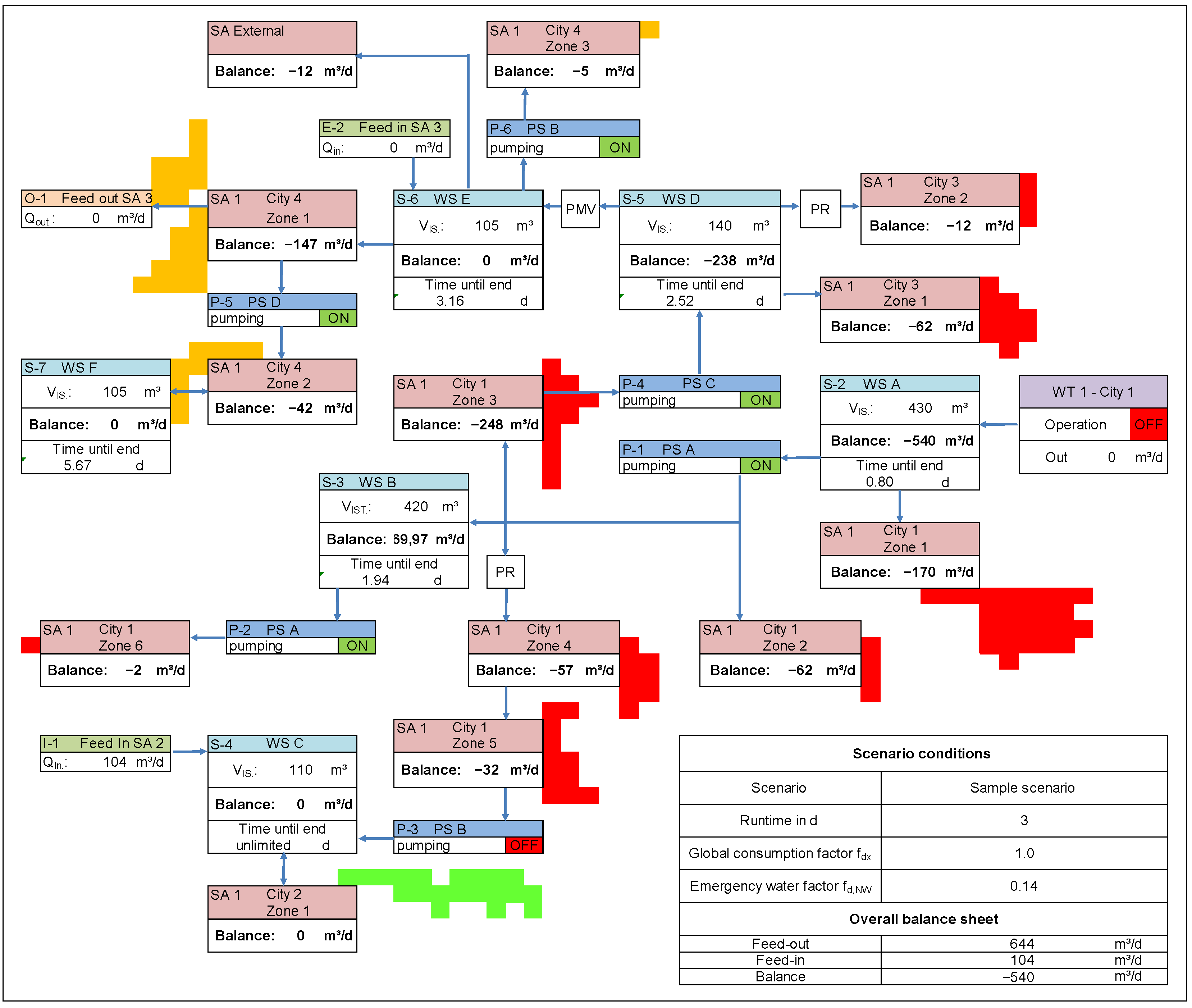
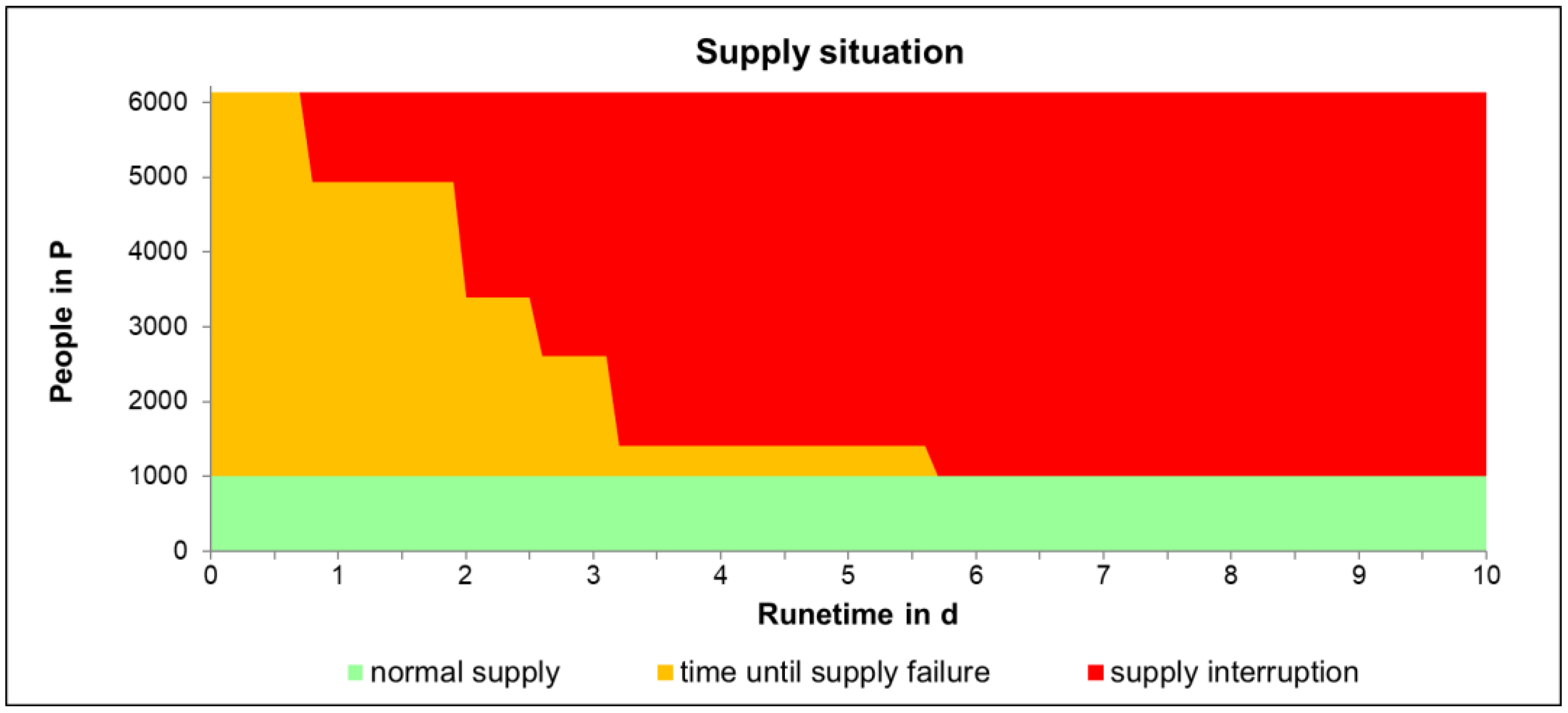
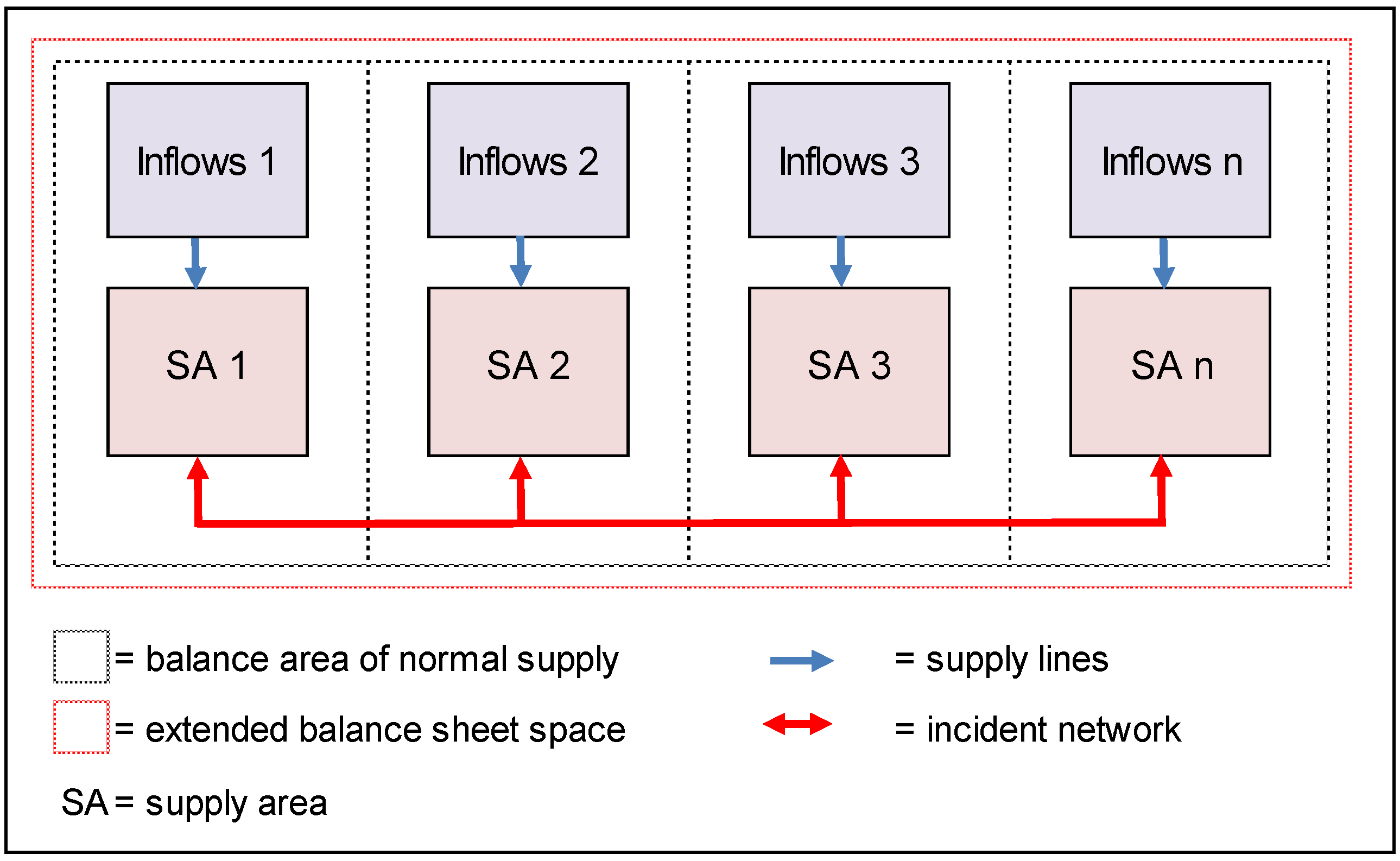
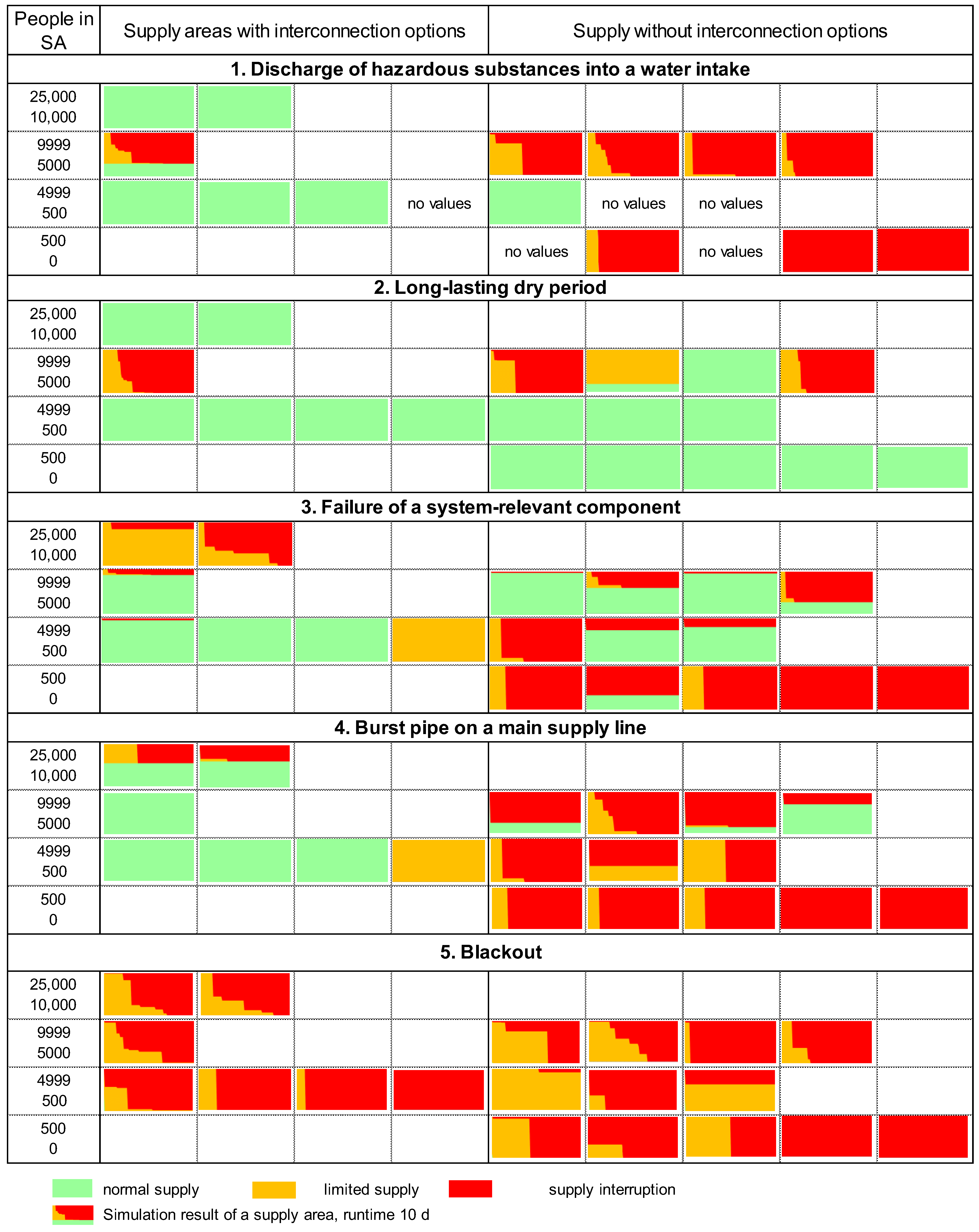
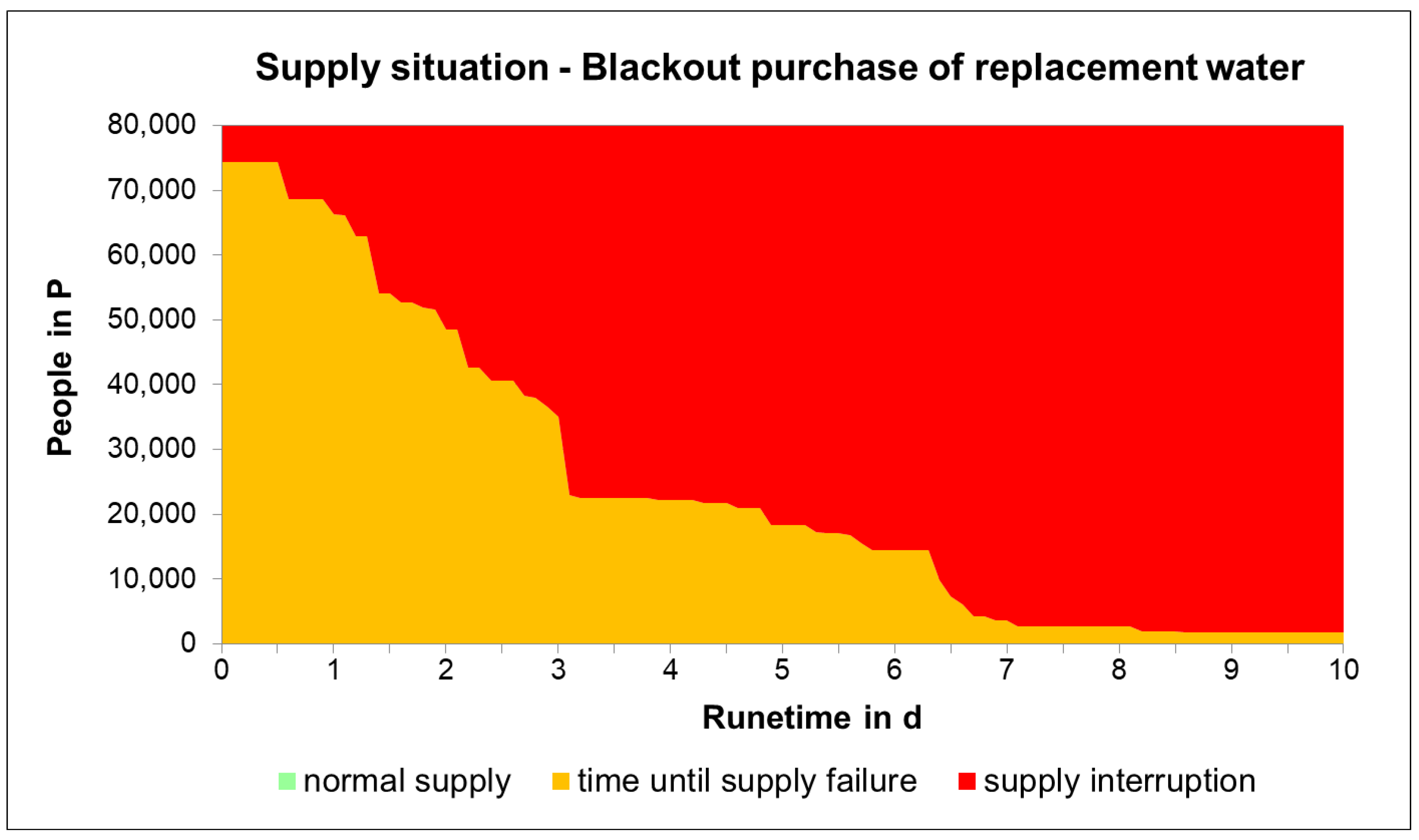

| Literature Source | Unit | WHO [43] | Sphere [44] | Switzerland [45] | Austria [46] | Germany [47] |
|---|---|---|---|---|---|---|
| Emergency water supply Minimum population requirement | L/(P·d) | 20 | 15 | 15 | 15 | 15 |
| Replacement water supply incl. domestic hygiene | L/(P·d) | 70 | 100 * | Accord. to water demand plan * | 50 * |
| A | B | C | D | E | F | G | H | I | J | K | L | M | N | O | P | Q | R | S | T | U |
| hazard analysis | ||||||||||||||||||||
| Hazards | Source | Reason | Responsible | Affectedness | Relevance | |||||||||||||||
| Category | No. | Hazard source | Drinking water supply safety guidelines [3] | Protection of critical infrastructures [1,49] | DVGW W 1001-B1 [50] | Incident documentationof the water supplier | Internal | External | Exposure in the supply area | Water supplier | Country/ Municipality | Covenant | Plants, buildings | Drinking water network | Staff | Region | Degree of danger | Probability ofoccurrence | Relevance | Evaluation of scenario selection, comments |
| N | 1 | Hazard 1 | X | X | X | X | X | X | 1 | 1 | 1 | 1 | 1 | 3 | 3 | |||||
| T | 2 | Hazard 2 | X | X | X | X | X | X | 3 | 3 | 3 | 3 | 3 | 2 | 6 | Derive scenario | ||||
| A | n | Hazard n | X | X | X | X | 1 | 1 | 2 | 3 | 1.8 | 2 | 3.6 | |||||||
| N = natural hazards, T = technical faults/human error, A= attacks, sabotage, acts of war. | ||||||||||||||||||||
| Classification of the impact: | 1—not relevant, 2—localized impact, 3—widespread impact | |||||||||||||||||||
| Classification of the probability of occurrence: | 1—low, 2—medium, 3—high probability of occurrence | |||||||||||||||||||
| System Component | Parameters | Unit | Remarks | |
|---|---|---|---|---|
| Global | Global input field | Scenario | Description of the scenario | |
| Runtime | d | Depending on the scenario | ||
| Consumption factor fdx | has a constant effect over the entire scenario period and reflects increases or decreases in drinking water consumption | |||
| Emergency water factor fd,NW | acts constantly over the entire scenario time and calculates the required emergency water quantity | |||
| Remarks | ||||
| Connection points | All consumption points | |||
| Drinking water supply (inflows) | Feed-in | Designation/No. | Abbreviation “I” | |
| Capacity Qcap | m³/d | Decisive capacity of the feed-in (technical or regulatory) | ||
| Feed-in QInput | m³/d | Actual feed-in in the scenario, with reference Qdm of the feed-in | ||
| Connection points | Feed-in point grid, water storage, water pumping | |||
| Water catchments | Designation/No. | Abbreviation “WC” | ||
| Usability | % | Utilisation of capacity, consideration of e.g., reduction due to dry periods | ||
| Capacity Qcap | m³/d | Decisive capacity of the feed-in (technical or regulatory) | ||
| Connection points | Water treatment | |||
| Water treatment | Designation/No. | Abbreviation “WT” | ||
| Operational switching | Selector switch between “ON” and “OFF” | |||
| Capacity Qcap | m³/d | Decisive capacity of the feed-in (technical or regulatory) | ||
| Connection points | Feed-in point grid, water storage, water pumping | |||
| Drinking water network | Water reservoir | Designation/No. | Abbreviation “S” | |
| Useful volume VUse | m³ | Available usable volume | ||
| Useful volume VIS | m³ | Minimum volume of normal operation | ||
| Connection points | Grid feed-ins and feed-outs, consumption points, water delivery | |||
| Water pumping | Designation/No. | Abbreviation “P” | ||
| Capacity Qcap | m³/d | Decisive capacity of the feed-in (technical or regulatory) | ||
| Connection points | Grid feed-ins and feed-outs, consumption points, water storage tanks | |||
| Drinking water consumption (drains) | Consumption point | Designation/No. | Abbreviation “SA” | |
| Inhabitants | P | Indication of inhabitants supplied | ||
| Storage system | Specification of linked memory | |||
| Consumption factor fdx | Selector switch “GLOBAL” or “HAND”, differentiated input required for “HAND”, e.g. for commercial customers | |||
| Manual value fdx | If “Hand” is preselected, it has a constant effect over the entire scenario time and maps excess or reduced quantities of drinking water consumption | |||
| Drinking water consumption | m³/d | Specification of drinking water consumption Qdm, as direct input or database link | ||
| Meter number | Specification of existing meter numbers | |||
| Connection points | Grid feed-ins and feed-outs, downstream consumption points, water storage tanks, drinking water consumption if applicable | |||
| Feed-out | Designation/No. | Abbreviation “O” | ||
| Capacity Qcap | m³/d | Relevant capacity of the feed-out (technical or regulatory) | ||
| Feed-out QFeed-out | m³/d | Actual feed-in in the scenario, with reference Qdm of the feed-in | ||
| Connection points | Grid feed-out point, water storage tank, water pumping |
| No. | Zone | People in P | Supply Time in d | Normal Supply in P | Limited Supply in P | Supply Interrup. in P | Qdm in m³/d | Qd,NW in m³/d | Sensitive Consumers |
|---|---|---|---|---|---|---|---|---|---|
| S-2 | City 1 Zone 1 | 1200 | 0.80 | 0 | 0 | 1200 | 169.8 | 23.8 | Nursing home A |
| S-3 | City1 Zone 2-5 | 1510 | 1.93 | 0 | 0 | 1510 | 129.6 | 18.1 | |
| P-2 | City 1 Zone 6 | 30 | 1.93 | 0 | 0 | 30 | 2.5 | 0.3 | |
| S-4 | City 2 Zone 1 | 1000 | unlimited | 0 | 1000 | 0 | 103.9 | 14.5 | |
| S-5 | City 3 Zone 1 | 780 | 2.52 | 0 | 0 | 780 | 73.8 | 10.3 | |
| S-6 | City 4 Zone 1 | 1030 | 3.16 | 0 | 1030 | 0 | 105.5 | 14.8 | Hospital B |
| S-6 | SA external | 120 | 3.16 | 0 | 120 | 0 | 11.7 | 1.6 | |
| P-6 | City 4 Zone 3 | 50 | 3.16 | 0 | 50 | 0 | 4.9 | 0.7 | |
| S-7 | City 4 Zone 2 | 410 | 5.67 | 0 | 410 | 0 | 41.9 | 5.9 | |
| Total | 6130 | 0 | 2610 | 3520 | 643.6 | 90.1 | |||
| Scenario | Consumption Factor (fdx) | Water Requirement (Qdx) | Remarks |
|---|---|---|---|
| Failure of system- relevant-component | = | No change in consumption behaviour | |
| Pipe burst | = | No change in consumption behaviour | |
| Hazardous substance input | = | No change in consumption behaviour | |
| Dry periods | = | = | Increased consumption |
| Blackout | = | Reduced consumption, Qd,EW = 50 l/(P∙d), flat rate industrial and commercial consumption, Qdm,HB= consumption of household and small business | |
| Emergency water supply | = | Qd,NW = 15 l/(P∙d)Determination of emergency water requirements in the event of a mains supply failure |
| No. | Source of Danger | Relevance | Evaluation of Scenario Selection, Comments |
|---|---|---|---|
| N-5 | Flooding water intake | 5.25 | 1st scenario: Hazardous substance entry |
| N-7 | Dryness | 9 | 2nd scenario: Long dry period with potential deficit in demand coverage |
| N-10 | Storm, tornado, thunderstorm | 5.25 | 3rd scenario: Failure of a system-relevant component |
| T-1 | Company organisation | 4.5 | Safeguarding via quality, environmental and energy management systems. |
| T-20 | Pipe burst on long-distance water pipe | 5.25 | 4th scenario: Burst pipe on a main supply line |
| T-21 | Feed-in of non-potable water | 6.75 | 1st scenario: Hazardous substance entry |
| T-22 | Power failure short, selective | 5.25 | 3rd scenario: Failure of a system-relevant component |
| T-23 | Long, widespread power outage | 6 | 5th scenario: Widespread power failure |
| T-24 | Information technology failure | 4.5 | 3rd scenario: Failure of a system-relevant component |
| T-28 | Accidents involving hazardous substances | 6 | 1st scenario: Hazardous substance entry |
| T-29 | Water pollution | 4.5 | 1st scenario: Hazardous substance entry |
| T-30 | Agricultural entries | 6 | 1st scenario: Hazardous substance entry |
| A-3 | Inadequate property protection, burglary, theft, vandalism | 4.5 | 3rd scenario: Failure of a system-relevant component |
| Natural Hazards | Technical and Human Error | Attacks, Sabotage, Acts of War |
|---|---|---|
| Flood | Failure of individual systems * | Cyberattack |
| Flash flood | Pipe burst on composite pipes | |
| Dryness | Blackout * | |
| Earthquake | Accidents with hazardous substances | |
| Large and wildfires | ||
| Epidemic, pandemic |
Disclaimer/Publisher’s Note: The statements, opinions and data contained in all publications are solely those of the individual author(s) and contributor(s) and not of MDPI and/or the editor(s). MDPI and/or the editor(s) disclaim responsibility for any injury to people or property resulting from any ideas, methods, instructions or products referred to in the content. |
© 2024 by the authors. Licensee MDPI, Basel, Switzerland. This article is an open access article distributed under the terms and conditions of the Creative Commons Attribution (CC BY) license (https://creativecommons.org/licenses/by/4.0/).
Share and Cite
Heumer, F.; Grischek, T.; Tränckner, J. Water Supply Security—Risk Management Instruments in Water Supply Companies. Water 2024, 16, 1814. https://doi.org/10.3390/w16131814
Heumer F, Grischek T, Tränckner J. Water Supply Security—Risk Management Instruments in Water Supply Companies. Water. 2024; 16(13):1814. https://doi.org/10.3390/w16131814
Chicago/Turabian StyleHeumer, Felix, Thomas Grischek, and Jens Tränckner. 2024. "Water Supply Security—Risk Management Instruments in Water Supply Companies" Water 16, no. 13: 1814. https://doi.org/10.3390/w16131814
APA StyleHeumer, F., Grischek, T., & Tränckner, J. (2024). Water Supply Security—Risk Management Instruments in Water Supply Companies. Water, 16(13), 1814. https://doi.org/10.3390/w16131814











